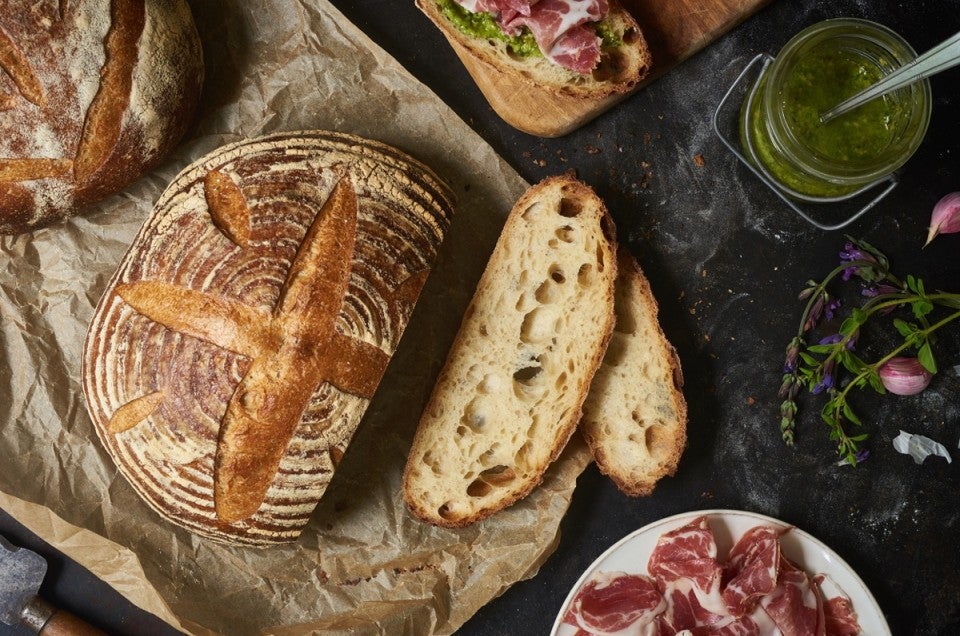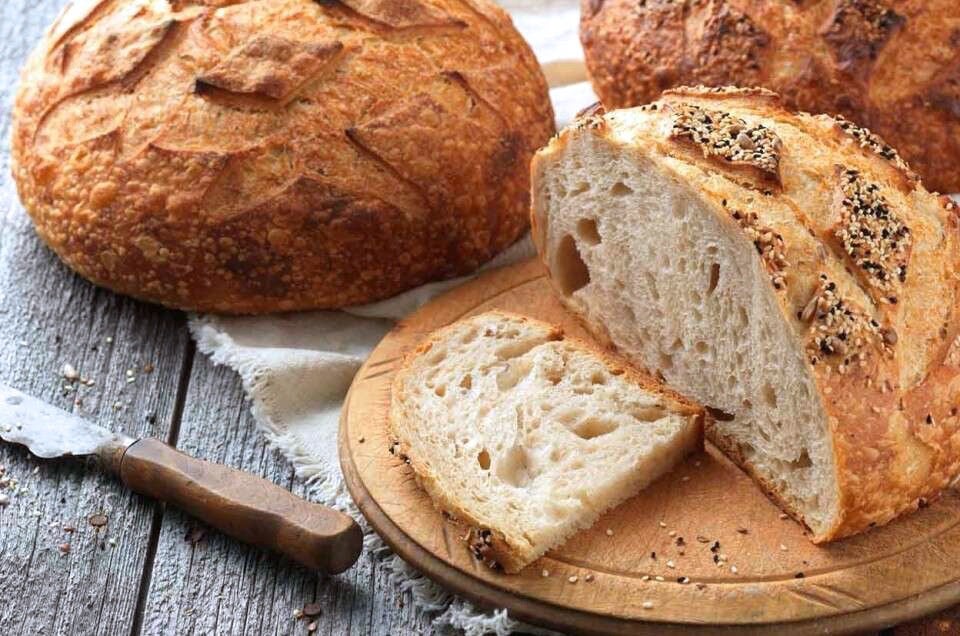How to make your sourdough bread more (or less) sour: part 3
Sour or mild — it’s up to you.


This is part 3 of a three-part series examining the tanginess of sourdough bread, and how to adjust it up or down. For this to make the most sense, please be sure you've read part 1 (on ensuring a healthy starter) and part 2 (examining the flavor components of typical sourdough) first.
* * *
At last, the answer to the question so many of you bakers ask: What can I do to increase (or decrease) the sour flavor in my sourdough bread?
The first post in this series taught you how to maintain a healthy sourdough starter, one whose two key components — yeast and lactic acid bacteria (LAB) — live and work in harmony.
The second post focused on identifying where acidity (and resulting sour flavor) come from in sourdough bread. We analyzed one of our favorite naturally leavened recipes, Pain au Levain, to see how its preferment and dough work together to produce this bread’s signature flavor: mildly (not assertively) tangy.
Now, sticking with that same Pain au Levain, we’ll outline just what steps you can take at each stage of the recipe to change the flavor of your bread. Super sour? You can do that. Barely tangy? You can do that, too. Using information from the first two posts in this series, let’s bake an even milder Pain au Levain, followed by one that’s assertively sour.
Let’s start with the current list of recipe ingredients; this will be the control for our two new versions.
Levain
Dough
Now I’ll go through the recipe part by part, breaking down what you can do at each stage to swing the sour meter from mild to assertively sour.
This loaf is going to be all about creating conditions that are more challenging for LAB. Since LAB are primarily responsible for the acids that dictate much of a loaf’s sourness, this first loaf of bread will be milder than the original.
Consistency: You’ll remember that stiffer conditions discourage LAB a bit more than yeast. Since higher-protein flour absorbs more liquid (and tends to make things stiffer), we’ll substitute higher-protein unbleached bread flour for unbleached all-purpose flour. This can help control LAB growth, and may even contribute to a stronger rise.
Temperature: The recipe calls for the levain to ferment overnight at 65°F to 75°F. It's tricky to change the temperature too significantly in the preferment stage when dealing with an overnight starter, so we’ll just leave this step as is; but if you have a cooler spot for your levain to dwell, aim for the lower end of the temperature range to help keep the LAB in check.
Ripeness: Since we’re trying to make a less-sour loaf, we want to continue to create conditions that are more challenging to LAB. So we’ll use the levain earlier in the window of ripeness (rather than past the peak, which tends to favor LAB). Look for the levain to be fully peaked, but not yet deflating.
Here’s the levain formula for a milder Pain au Levain. Note that going forward I’ll list the gram measurement first and the volume afterward, since metric weight is the most accurate way to measure your ingredients.
Flour: Since whole grain flour encourages LAB growth (and a higher concentration of acids), we’ll eliminate the original recipe’s rye flour, substituting an equal amount of unbleached bread flour. Bread flour in the dough may also contribute to a better rise.
Temperature: Cooler temperatures are going to continue to slow down LAB, so we’re aiming for a dough temperature of about 73°F to 74°F. Check out our post on desired dough temperature to determine what water temperature to use in your dough, depending on your own environmental conditions.
Immediate vs. delayed bake with refrigeration: The original recipe gives two options: allowing the shaped loaves to rise at room temperature for 2 hours, then baking; or shaping, then refrigerating the loaves for up to 16 hours before baking. We found that baking the loaves after 2 hours, without refrigeration, yields a milder bread. As always, adjust the timing so that your dough has risen appropriately before baking.
And here’s the dough formula for a milder Pain au Levain:
With this loaf, we’ll create conditions that favor LAB in order to make a tangier version of Pain au Levain.
Consistency and temperature: A “wetter” levain will encourage LAB production, so I substitute a higher hydration (125%) starter for the rather stiff starter in the original recipe.
I also grow the levain at warmer temperatures to encourage more LAB growth, mixing it with 90°F water and letting it ferment at 82°F. A wetter, warmer levain ferments much more quickly than a stiffer, cooler one; it will inevitably reach its peak and fall if left overnight. So if you try this, start your levain the same day you’ll be making your dough and keep your eye on it! Mine took about six hours to peak and start to fall.
Ripeness: I let the levain develop a little past its peak (just beginning to fall) before combining it with the remaining dough ingredients. This encourages an increase in LAB populations, which will hopefully result in higher concentrations of acids in the dough — meaning more sour flavor.
Here’s the levain formula for a more sour Pain au Levain:
Flour: In order to keep encouraging LAB development I just about double the amount of rye flour in the dough, substituting the additional rye for some of the all-purpose flour; LAB love whole grains!
Temperature: Since warmer rising temperatures will encourage more LAB activity in the dough, I let our warm dough (78°F to 80°F) rise in a proof box set at 82°F.
For those of you who don’t have a proof box, here are some tips for achieving a warm rise. And if you tend to stop baking bread in the summer because of the heat, you may find you’re missing out on a great opportunity to develop more sour flavor in your sourdough bread, just by taking advantage of your warmer kitchen temperatures.
Immediate vs. delayed bake with refrigeration: Doing bulk fermentation (the dough’s initial rise) at a relatively warm temperature allows plenty of LAB growth, establishing the potential for a high concentration of organic acids. Refrigerating the shaped loaves before baking tends to shift the ratio of acetic acid to lactic acid produced, which can also provide more depth of flavor.
Here’s the dough formula for a more sour Pain au Levain. I increase the amount of water in the levain, so in order to keep the flour/water ratio the same as in the original recipe I reduce the amount of water in the dough:
*To determine exact temperature, use the DDT formula; you’re looking for a final dough temperature of 79°F to 83°F.
Oftentimes you run across a new sourdough bread recipe you want to try but are uncertain whether the result will be mildly tangy or super sour. Some naturally leavened bread recipes are developed to deliver extra-sour flavor, while others concentrate more on rise, texture, and the more subtle flavors of the grain and fermentation (which can be overwhelmed by sourness).
By now, you should be somewhat familiar with what factors are most responsible for delivering tanginess. To reiterate, here are the main drivers to look for in any particular sourdough bread recipe:
For milder bread, the preferment should be:
And the dough should be:
While we’ve been emphasizing adjusting sourness during the preferment and dough stages throughout this series, it’s important to note that starting with a well-fed, active, and vigorous starter is especially important if you want to keep your bread mild and light in texture.
Perpetuating the starter on the young (perhaps even a tad underripe) side works well to develop strong leavening and reduced acidity in the starter itself. And when managed in a way to build on those features, that translates into more potential for mild levain and dough.
For bread with stronger sour flavor, the preferment should be:
And the dough should be:
Have you ever reached the point of shaping your sourdough bread and found that your dough is extremely wet and tears easily? Chances are the structure is beginning to break down as a result of over-fermentation and acidification.
One factor we haven’t considered in all of this is the rheology of the dough. Rheology might be a scary physics word, but in the world of bread dough it simply refers to the handling properties of the dough.
Fermentation and the increased souring of the dough weaken its gluten and ultimately lead to deterioration in its structure. So if we’re working to make our bread extremely sour by increasing its acidity, we also have to expect that going a bit too far on the sourness scale could yield bread that doesn’t rise well.
In fact, the warmer, wetter, more whole grains factors that lead to more sourness also tend to accelerate proteolytic activity (the breakdown of proteins). In theory these conditions make the most sense for souring, but in practice this combination can be a double-edged sword because they also hasten gluten degradation.
This is part of the reason it’s difficult to offer a precise roadmap to sourness. Sometimes working with a warmer stiff levain can still get you the sourness you’re looking for and won’t accelerate dough deterioration quite as much as a warm, wet levain. Bread flour with its higher protein content can also be a good choice in your quest for sour if you find your dough has a tendency to break down when using a lower-protein flour.

With all the variables that go into sourdough flavor, figuring out which recipes will deliver the most sour flavor can be daunting. With that in mind, I’ve done some testing and determined which recipes on our site are most likely to deliver bread with strong sour flavor:
Pain de Campagne
Do-Nothing Sourdough Bread
Multigrain Sourdough Sandwich Bread
No-Knead Sourdough Bread
Extra-Tangy Sourdough Bread
Vermont Sourdough Bread
Artisan Sourdough Bread made with a stiff starter
Remember, there are always multiple factors at work in sourdough bread, and as much as I’d like to offer you a simple “If you do X, you’ll get sour bread” scenario, sourdough flavor is never that simple. Think of it as a juggling act, with many, many balls in the air. Knowing what each ball contributes is helpful, but keeping them in balance and flowing is the real art and science of sourdough bread baking.
I hope you’ll share your questions and experiences below as we continue to hone our juggling skills.
Read more:
How to make your sourdough bread more (or less) sour: part 1
How to make your sourdough bread more (or less) sour: part 2
Our thanks to microbiologist and sourdough scientist Debra Wink, without whose knowledge and insight this article wouldn’t have been possible.
Cover photo (Pain au Levain) by Liz Neily.